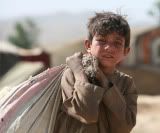{Photo: Akmal Dawi/IRIN
Shah Wali, a father of five, forced by fighting to leave Helmand Province and come to Kabul}
3 November 2010 (IRIN) - The UN Refugee Agency (UNHCR) says it is concerned about the growing number of internally displaced persons (IDPs) caused by conflict in Afghanistan, and the fact that it is often too dangerous to assist them.
Between June 2009 and September 2010, 120,000 people were forced out of their homes by armed conflict, increasing the number of IDPs to 319,000, it said.
“These figures do not include IDPs scattered in urban/semi-urban locations for which systematic accounting is problematic. These figures equally do not reflect IDP groups that have scattered across the inaccessible areas of the southern swathe of the country following recent armed offensives,” Nader Farhad, a UNHCR spokesman in Kabul, told IRIN.
In addition to conflict, some people are displaced by natural disasters (primarily floods), loss of livelihoods, and land disputes, aid workers say. The Ministry of Refugees and Returnees Affairs (MoRR) puts the total number of IDPs at nearly 500,000.
Most IDPs are in the insecure south and east of the country and many are not accessible by aid workers.{A young boy carries a heavy bag in an IDP camp in Kabul, Afghanistan}
As winter approaches, UNHCR said it was planning to distribute warm clothes, charcoal and blankets to thousands of “extremely vulnerable” IDPs, and the UN World Food Programme (WFP) said it was working closely with UNHCR to assist IDPs.
“WFP has been distributing a three-month emergency food ration to over 43,000 recently displaced people,” WFP spokesman Challiss McDonough told IRIN, adding that the organization would provide special winter food assistance to 320,000 vulnerable families - not all of them IDPs - across the country.
The government is also moving to help IDPs: “We have submitted a request for US$5 million to the President’s Office which, if approved, will be used to respond to some of the basic needs of IDPs,” said the MoRR’s Islamuddin Joraat. {read rest}
We know the costs in blood, never to totally in civilians, but what of the costs in treasury still not paid! How much to buy the coalition of the willing, how much to buy the CIA rendition and secret prisons globalizing torture, how much for the decades to come as to the results of both wars, more. Neither has been paid for, rubber stamping and rapid deficit rises started Before 9/11 and nothing as to the peoples responsibility, the VA, as to just one of the needs in those results from!
Pages
In 2003 some 72% of Americans fully supported the Abandoning of the Missions and those Sent to Accomplish so extremely Quickly after 9/11!!At least some 95%, if not more as less then 1% serve them, not only still support the, just below, total lack of Sacrifice, they ran from any and all Accountability and left everything still on the table to be continually used if the political/military want was still in play in future executive/legislative wants!!
DeJa-Vu: “With no shared sacrifices being asked of civilians after Sept. 11", Decades and War From, All Over Again!! 
DEC. 21, 2014 - Prosecute Torturers and Their Bosses ‘Operation Inherent Resolve’


Resolute Support Mission in Afghanistan

* * Iraq: 10 Years After, 19 March 2013 - Costs of War * * CNN Map U.S. and Coalition Iraq/Afghanistan Casualties


Civilian Fatalities in Afghanistan, 2001–2012 
* Bookshelf * Iraq War Inquiry * The Torture Archive * Donate * Subscribe *




* * Operation Resolute Support * *



Wednesday, November 3, 2010
Afghanistan: Internally Displaced Persons (IDPs)
Subscribe to:
Post Comments (Atom)

No comments:
Post a Comment